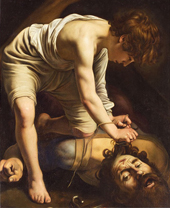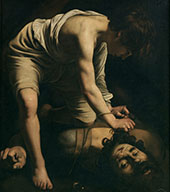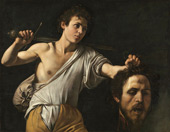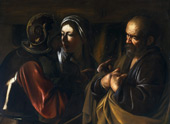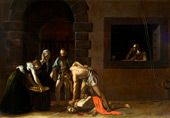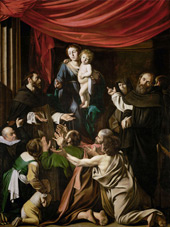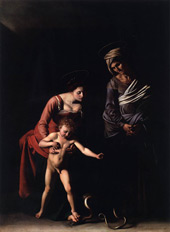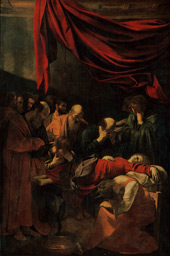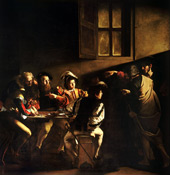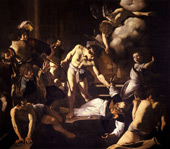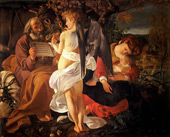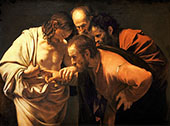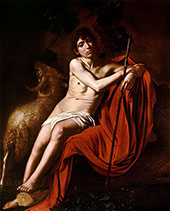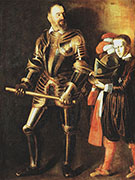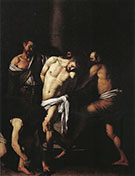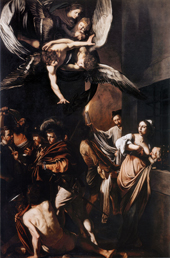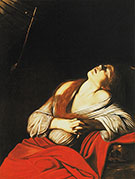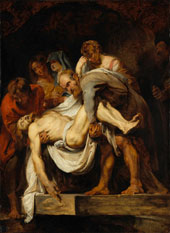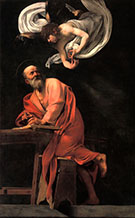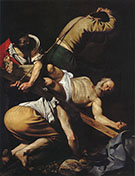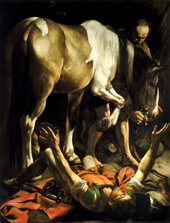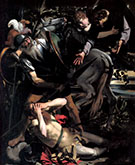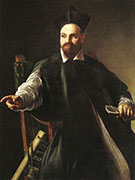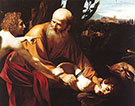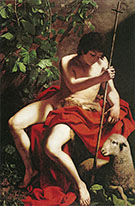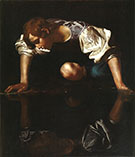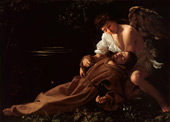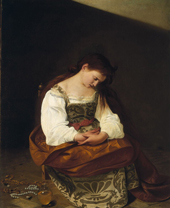Caravaggio Oil Painting Reproductions
Caravaggio replica paintings on Canvas for sale
Caravaggio Baroque and Renaissance Paintings
Michelangelo Merisi da Caravaggio, best known simply as Caravaggio. He is famous for Baroque period art and Renaissance paintings. His Religious Art can be seen in churches and chapels throughout Rome.
Born in Milan, Italy, in 1571, he lived a short, chaotic, and troubled life. Throughout the 1570s, the Bubonic Plague ravaged many Italian cities. Consequently, the family relocated to the town of Caravaggio in 1576. The young child’s grandparents died from the plague when he was just six years old, and his mother died from the disease when he was 10. Caravaggio’s artistic talents were evident from an early age. Aged 12, he commenced an artistic apprenticeship in the studio of Simone Peterzano. After four years of working as an apprentice, he moved to Rome. In the late 1580s, a spate of Italian church buildings meant a strong demand for high-caliber artists for religious paintings.
Caravaggio's Religious Art
At the start of his career, the Catholic Church sought oil paintings offering an alternative to the Mannerism paintings of the past. They also hoped to counter the Protestant Reformation with a new, naturalistic style of communicating religion to the masses. Caravaggio's paintings, with their style of realistic yet vivid chiaroscuro and dramatic juxtapositions of light and dark, were perfect for this purpose. Boy Peeling a Fruit, Boy with Basket of Fruit, and Young Sick Bacchus c1593 reflect this early, intensely dramatic style.
During this period, Caravaggio met influential artists and earned patrons such as the architect Onorio Longhini and the painter Prospero Orsi who introduced him to wealthy Roman society. Caravaggio's religious paintings initially focused on scenes from the New Testament. However, he was a true innovator, prioritizing the mundane, everyday aspects of biblical narratives and transforming them to new heights. Controversially, the artist often used street people as models for figures such as Mary and the Apostles. Heightened by theatrical lighting and shallow pictorial space, it launched a new age of realism in religious art.
Due to their shocking nature, the church rejected many early Caravaggio paintings. Indeed, rumors abounded that in his oil painting Death of the Virgin 1601, Mary was based on the body of a dead prostitute who had drowned in the Tiber. Interestingly, the painting was later purchased by the Duke of Mantua on the recommendation of the artist Peter Paul Rubens, famous for his painting The Conversion of St Paul.
Why are Caravaggio's Paintings Famous?
Caravaggio's fame and reputation quickly grew despite or perhaps because of the scandals surrounding him. Known for their dramatic lighting, Caravaggio's paintings contain a rich, jewel-toned palette of color. His oil paintings harmonize theatrical compositions with biblical narratives as part of the Catholic counter-reformation. Caravaggio's paintings, Judith Beheading Holofernes 1599 and The Incredulity of St Thomas 1602 illustrate the intense skill and drama that make his Renaissance paintings some of the most famous 16th art. Indeed, every composition tells a story understood by believers of all social echelons.
Caravaggio also frequently created Greek mythological paintings, exemplified in oil paintings such as Bacchus c1596. Early oil paintings, such as The Cardsharps 1594 and The Fortune Teller 1598, represent everyday scenes. With their fantastic detail and rich psychological insight, Caravaggio's paintings impressed a prominent collector, Francesco Cardinal Del Monte. The Cardinal was one of Caravaggio’s first patrons, providing him with lodgings and many beneficial introductions to Roman society.
What are Caravaggio's Masterpiece Religious Paintings?
These social connections provided by Cardinal Del Monte led to Caravaggio’s most important commissions for two paintings for the Contarelli Chapel in Rome. Today, they are shining masterpieces of Baroque Art and Renaissance paintings. These are The Calling of Saint Matthew and The Martyrdom of Saint Matthew. Painted between 1599 and 1600, they remain in the Church of San Luigi dei Francesi. Caravaggios's paintings were an immediate success and greatly admired; he never struggled for commissions again.
Representing stories from the Gospel of Matthew, the artist boldly places Jesus Christ and the saints in tawdry, dark settings. This realistic presentation contrasts the shining light of faith with worldly attire, mundane interiors, and everyday activities. Even today, Caravaggio’s religious paintings retain their emotional power. Pope Francis frequently spoke of visits to The Calling of Saint Matthew, simply commenting, “This is me.” Yet, even the Pope saw himself in Caravaggio’s art as a “sinner on whom the Lord has turned his gaze.”
As well as the paintings in the Contarelli Chapel, Caravaggio’s Betrayal of Christ, Entombment of Christ, and The Seven Works of Mercy are also acknowledged as important religious paintings.
Are Michelangelo and Caravaggio the same person?
As a frequently asked question, it is worthwhile noting that Caravaggio’s real name was Michelangelo Merisi. However, he is not the artist Michelangelo Buonarroti, known simply as Michelangelo. The great Michelangelo lived from 1475 to 1564 and died before Caravaggio’s birth in 1571.
While Michelangelo largely avoided public scandal, Caravaggio was known for his quick temper, many lovers, and frequent brawls. He committed many minor crimes, such as swearing at a constable, cutting a hole in his landlord’s ceiling to allow light for painting, and carrying a sword without a license. More serious crimes include scarring a guard during a fight and throwing a plate directly in the face of a waiter. The incident occurred because Caravaggio believed his undercooked artichokes were an insult.
Why was Caravaggio Exiled?
Ultimately, Caravaggio’s fiery temper was his downfall. He killed Ranuccio Tomassoni in a duel after Tomassoni insulted a prostitute Caravaggio particularly admired. Scholars speculate the two men also had gambling debts. However, rather than risking execution for the crime, his exile served as punishment for Tomassoni’s murder.
Caravaggio consequently fled Rome heading for Naples. While in exile, he hid with multiple noble families and patrons, such as the Sforzas and the Colonnas. During this period, he continued to work and painted several masterpieces, including The Beheading of Saint John the Baptist and Saint Jerome Writing, the only painting signed by Caravaggio.
Despite this, Caravaggio fled Malta after yet another fight. On this occasion, he seriously wounded a high-ranking knight and again escaped prison. He traveled to Sicily under the protection of an old artist friend, Mario Minniti, and painted the Adoration of the Shepherds on the picturesque Italian island. Nonetheless, the artist lived in constant fear and paranoia. His suspicion proved well-founded after a group of men attacked him in possible retaliation for the attack on the Maltese knight. Caravaggio’s face was permanently disfigured.
Why was Caravaggio killed?
It is unknown whether Caravaggio died of natural causes or if he was murdered. We know that he died at some point in July 1610 while still attempting to obtain a Papal pardon for the murder of Ranuccio Tomassoni. However, this famous Baroque and Renaissance artist probably died from syphilis, malaria, or brucellosis. Nonetheless, some art historians speculate that Caravaggio was killed in retribution for the death of either Tomassoni or the Knight, he attacked in Malta.
A recent discovery in 2010 identified bones likely to be those of Caravaggio. They reveal toxic lead levels, perhaps absorbed from the paints he used. His painting style was incredibly physical and erratic and supported this theory. Furthermore, unpredictable and violent behavior is also a common symptom of lead poisoning. Whatever the cause of death, Caravaggio died at the age of 38 in Spain. He was en route to the Pope after hearing a pardon was due.
What was Caravaggio's influence?
Caravaggio's paintings greatly influenced late Renaissance Art and Baroque movements. In the words of the art historian Bernard Berenson, “no other Italian painter has exercised so great an influence” on European art.
Even artists of the time called themselves “Caravaggisti.” Indeed, leading painters such as Bartolomeo Manfredi, Carlo Saraceni, Battistello Caracciolo, and Artemisia Gentileschi started following his pioneering techniques, heightened naturalism, and dramatic compositions. Furthermore, Peter Paul Rubens, Diego Velasquez, and Rembrandt van Rijn admired Caravaggio paintings. His use of tenebrism, a painting style characterized by dark tones with contrasting light effects, is particularly evident in many of Rembrandt’s famous paintings.
Buy Caravaggio Oil Paintings Reproductions.
If you love stunning Renaissance paintings, explore our collection of museum quality oil paintings on canvas.
Buy fine art reproductions of Caravaggio paintings. Discover replica paintings of Renaissance paintings from Leonardo da Vinci, Raphael, or Titian. We have been creating hand-painted oil on canvas art since 1996. Our Money Back Guarantee covers standard catalog paintings; INTERNATIONAL SHIPPING IS FREE wherever you are.
Testimonial from Cristian B, Waterloo, Ontario
Cannot Find What You Are Looking For?
Reproduction Gallery Information
Customer Service
(Send Us A Message)
Tel: (503) 937 2010
Fax: (503) 937 2011


